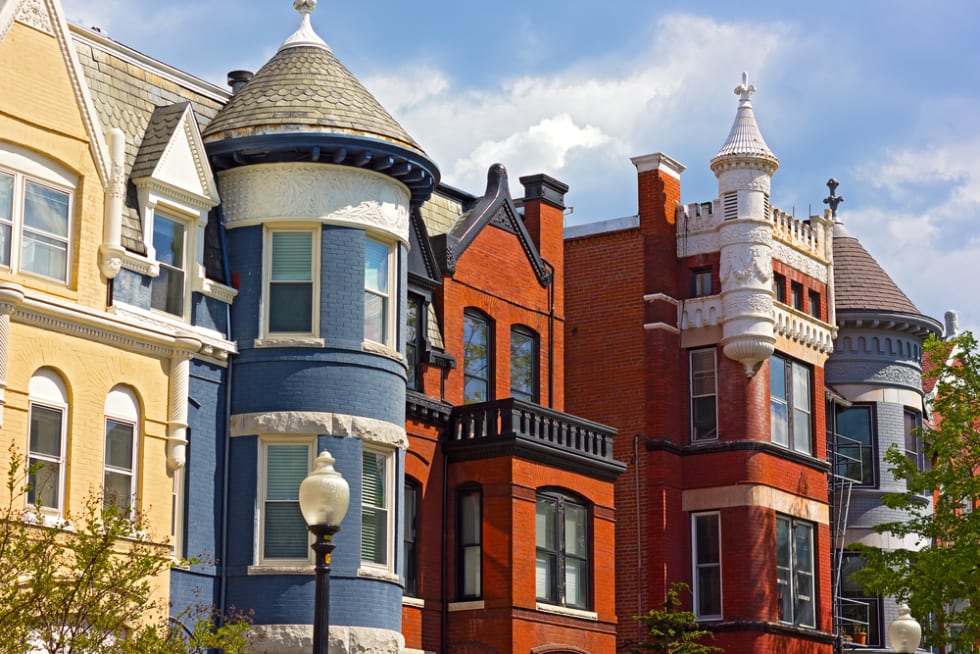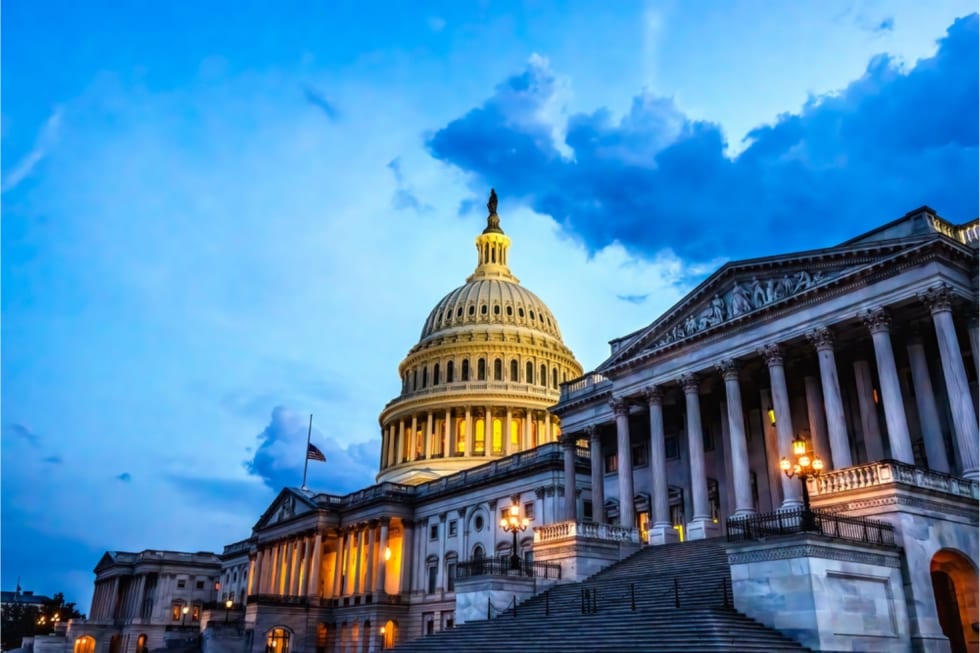The Wren D.C.
- 41 units available
- Studio • 1 bed • 2 bed
- Amenities
In unit laundry, Nest technology, Patio / balcony, Granite counters, Hardwood floors, Dishwasher + more

Ready to find an apartment in Washington, DC, but not sure where to start your search? We’ve got you. From rent prices to the best neighborhoods, this guide breaks down everything you need to know to find your next place in the nation’s capital.
DC, or The District, is a city packed with career opportunities, world-class museums, and neighborhoods that each have their own personality. Whether you’re relocating for work, school, or just craving a change of scenery, apartment searching here can feel overwhelming. But with the right info (and a game plan), you’ll be ready to make your DC move without the stress.
As of August 2025, the overall median rent in Washington DC is $2,213. A one-bedroom apartment will cost you around $2,188 whereas two-bedrooms will be closer to $2,246. Overall, rent prices are down 0.6% from last year.
Your dream apartment starts with the right neighborhood. If you’re not local, this can feel like guesswork—but we’ve done the heavy lifting for you. Below are a few standout neighborhoods, complete with average rents. Want a deeper dive? Check out our Washington, DC neighborhoods guide to find even more options.
The averages below reflect current (August 2025) apartment listings on our website, cross-referenced with neighborhood data from Rent.com.
Adams Morgan pairs colorful 19th‑century rowhouses with lively streets, late‑night eats, and easy walking and biking. On the weekends, you’ll find pocket parks, a beloved community garden, and the annual Adams Morgan Day festival. Commuters can hop on the Red Line** **nearby for quick trips downtown.
Named for the central traffic circle with its shady park, Dupont Circle is known for cafes, bookstores, galleries, and late‑night options. Architecture fans will spot grand rowhouses and apartments from the late 1800s. Walk a few blocks to Embassy Row and you’ll pass embassies and consulates from around the world.

Home to Georgetown University, Georgetown blends old-world charm with modern convenience. Its cobblestone streets, Federal-style rowhouses, and leafy side alleys give it that classic DC feel.
The area pulses with student energy, while upscale shops, designer boutiques, and national retailers keep M Street and Wisconsin Avenue buzzing. Nature is part of the package, too, with Georgetown Waterfront Park outside your doorstep.
Capitol Hill’s name says it all—landmarks like the U.S. Capitol and Supreme Court are neighborhood fixtures. Most people working in the government reside in this Washington, DC neighborhood.
But you don’t have to be heavy into politics to enjoy living in Capitol Hill. You’ll find plenty to do here, including shopping along vintage storefronts or dining at top restaurants in the area.
Foggy Bottom may have an interesting name, but living here comes with tons of perks. Sitting between the Potomac River and downtown DC, it’s conveniently located next to George Washington University.
Beyond campus, you’ll find the Kennedy Center for the Performing Arts, historic row houses, and even the infamous Watergate complex. Outdoor time comes easy with Rock Creek Park and Potomac River paths nearby.

Rent prices in DC follow seasonal trends. January is typically the cheapest month to sign a lease, while August and September are the most competitive (and expensive). Winter moves might mean more availability and less competition, but brace yourself for cold weather on move-in day.
No matter when you search, come prepared. Having your paperwork ready could be the difference between scoring your first-choice apartment and missing out.
A simple way to calculate your rental budget is by following the recommended 30% rule. Translation: aim to spend no more than 30% of your gross income on rent. At the current median rate of $2,213 per month, you’d need to earn around $88,520 a year to comfortably afford an apartment. This amount covers all your basic expenses, plus extra for entertainment and savings.
MIT has a more complicated living wage calculation that covers how much you’d need for basic necessities, and estimates that a single person would need to earn $60,840 annually before taxes to live in DC. Keep in mind, this amount doesn’t account for savings or entertainment.
While the 30% rule is a helpful budgeting tool, think of it as a starting point. There are hidden costs for renting that the 30% rule doesn’t account for in terms of budgeting, so you’ll need to factor those into your budget, too.
Some of the most common apartment expenses include:
How much rent you can actually afford depends on your personal finances. If you’ve got big monthly bills (medical costs, student loans, etc.), the 30% rule might not fit your reality. You may need to adjust your budget to make things work.
That’s why it’s so important to figure out what you can really afford, not just in rent, but with everything else you pay for each month. We recommend using the Apartment List Rent Calculator to see what kind of budget you’re working with before you start your search.
Washington, DC has everything from 19th-century rowhouses to sleek new high-rises. Once your budget’s set, figure out your must-have amenities: in-unit laundry, walkability, bike storage, or covered parking.
Make two lists: need and nice‑to‑have. Consider transit access, bike storage, covered parking, in‑unit laundry, air conditioning, and soundproofing. The clearer your priorities, the faster you’ll filter out maybes and focus on real contenders.
Finding the best neighborhood in Washington, DC for you comes down to personal preference. The good news? There are a ton of great neighborhoods to choose from.
Factor in things like the overall vibe, walkability, and convenience. If you want quieter evenings (or a yard), look a bit farther from downtown. If you want restaurants and late‑night options at your doorstep, aim closer in. Map your regular spots—gym, grocery, friends—and choose accordingly.
Need to find a place close to work? Make sure you’re factoring commute times in your apartment search.
Washington, DC has a pretty high Walk Score (76) and Bike Score (70), meaning many errands, and even some commutes, are doable without a car. If cutting your commute trims costs and stress, prioritize that in your search.
Washington, DC's public transportation makes it easy to get around the city. The Washington Metropolitan Area Transit Authority (WMATA) and bus network connect most neighborhoods to job centers, schools, and airports. Use the trip planner to preview routes and fares before you tour.
Between transit, walkability, and bike routes, many renters skip car ownership altogether. Consider proximity to Metro stops and bike paths when comparing buildings.
Before signing a lease for your new Washington, DC apartment, take the time to check out the place in person. When it’s time to tour, don’t forget to bring:
Property managers may accept cash, credit card, or check for the application fee, so you may want to check ahead of time.
Before you go, ask about the application steps and timing. Take your time on the tour and don’t feel rushed. Test appliances, run faucets, check water pressure, and confirm what’s included (parking, storage, utilities). Come prepared with questions, like pet rules, painting, noise policies, and renewal terms.
Once you’ve wrapped up your apartment tours and finally found the Washington, DC spot that feels like “the one,” it’s time to make your move.
The good news? You’ve probably gathered most of the paperwork already for your tour, so the application itself should be smooth. Standard requirements usually include:
Most landlords prefer references from previous landlords—they want to know you paid rent on time and treated the apartment well. But if this is your first place, don’t panic. Many property managers are open to personal references instead, whether that’s a boss, a professor, or someone who can vouch for your reliability.
Pro tip: always give your references a heads-up before listing them. That way, when the leasing office calls, your contacts can respond quickly, keeping your application at the top of the pile.
According to a 2018 rental fraud report by Apartment List, 34.1% of renters in Washington, DC have encountered an apartment listing they have suspected was fraudulent. Sadly, 9.3% of DC renters lost money from one of these rental scams.
Always be cautious and follow these tips for avoiding rental scams to keep yourself protected.
You’ve done the research, compared neighborhoods, toured apartments, and prepped your budget. Now it’s time to lock down the perfect place.
Get started with Apartment List’s personalized quiz and get matched with apartments that fit your budget, commute, and must-haves. With us, you’ll spend five minutes and save 50 hours searching (and avoid the endless doom-scroll).
The median monthly homeowner costs in Washington, DC are $3,052 per month (including mortgage). Our rental estimates show that the current median rent in the city is $2,213, suggesting that many will find it cheaper to rent than to own in Washington, DC.
As of August 2025, the median rent in Washington DC is $2,213 per month. That overall total reflects a median cost of $2,188 for a one-bedroom apartment and $2,246 for a two-bedroom unit.
The “best” neighborhood really depends on your lifestyle and priorities. If high walkability matters, U-Street has a super high Walk Score (99) and upbeat community vibe. If you value quiet, suburban streets and easy access to outdoor activities, check out Mount Pleasant.
As of August 2025, the average rent in Washington, DC is $2,972. Prices are down 0.6% from last year.
Winter is typically the cheapest month to sign a lease, while peak summer months (August and September) are the most competitive—and expensive.
Several DC neighborhoods offer lower rents than the citywide average, including pockets of Fairfax - Hillcrest Village, Fort Dupont, and Adams Morgan. We’ve also narrowed down some DC’s cheapest apartments across several renter-favorite neighborhoods.
Landlords in DC typically require proof of income (pay stub or offer letter), government-issued ID, credit and/or rental history, proof of insurance, and references.
It depends on the building and landlord. Some DC rentals advertise “utilities included,” but that doesn’t mean every bill is covered. Typically, included utilities are water, sewer, and trash removal. In some smaller apartment buildings or older units, heat and gas may also be part of the rent. Electricity and internet, however, are more often left to the renter.


In unit laundry, Nest technology, Patio / balcony, Granite counters, Hardwood floors, Dishwasher + more
In unit laundry, Patio / balcony, Dishwasher, Pet friendly, New construction, Garage + more